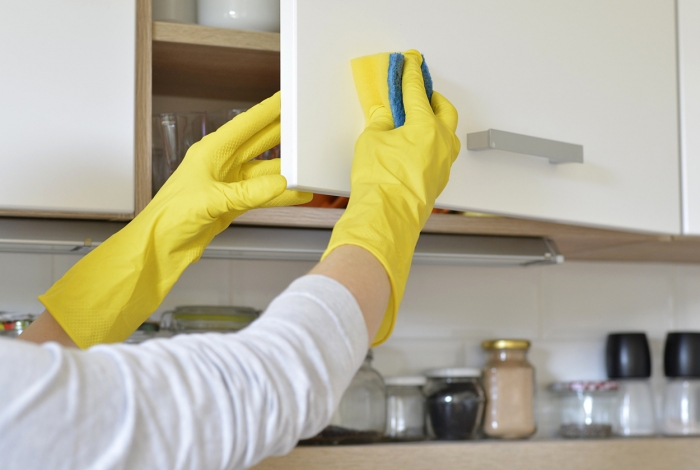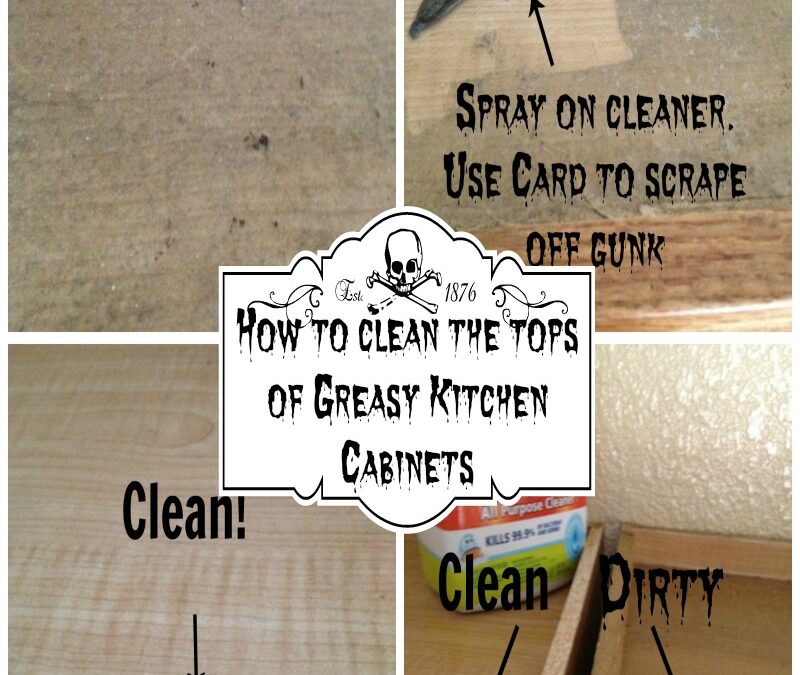You’ve just finished wiping down your kitchen cabinets, expecting them to shine and feel smooth to the touch. But instead, you find them sticky and less than satisfying.
Sound familiar? You’re not alone. This common cleaning conundrum can be frustrating, leaving you wondering what went wrong. Is it the cleaner you’re using, or is there something more to it? Understanding why your kitchen cabinets remain sticky after cleaning can save you time, effort, and a lot of frustration.
We’ll uncover the reasons behind that persistent stickiness and provide you with practical solutions to ensure your cabinets not only look clean but feel clean too. Keep reading, because a fresh, spotless kitchen is within your reach.
Common Causes Of Sticky Cabinets
Your kitchen cabinets are clean, but they still feel sticky. It’s a frustrating experience that many people face. Understanding the common causes of sticky cabinets can help you achieve the spotless and smooth surfaces you desire.
Residue From Cleaning Products
Have you ever noticed your cabinets are sticky right after cleaning them? Residue from cleaning products might be the culprit. Some cleaners contain oils or waxes, which can leave a tacky film.
Check the labels of your cleaning products. Avoid those that contain oily substances unless specifically formulated for wood cabinets. A simple mix of vinegar and water can often be more effective, leaving no residue.
Cooking Grease And Steam
Do you cook frequently? Cooking grease and steam can settle on your cabinets, creating a sticky surface over time. Grease particles travel through the air and attach themselves to surfaces.
Regularly wipe down your cabinets after cooking to prevent buildup. Installing a good range hood can also reduce the amount of grease and steam reaching your cabinets. Do you have a favorite dish that’s especially greasy? Consider the impact it might have on your kitchen surfaces.
Improper Cleaning Techniques
Sometimes, how you clean is just as important as what you use to clean. Using too much water can make cabinets sticky, especially if they’re made of wood. Wood absorbs moisture, leading to a tacky feel.
Use a soft cloth instead of a sponge, as sponges can spread dirt and moisture. Wipe cabinets dry immediately after cleaning to prevent moisture absorption. Have you ever left a wet cloth on a wooden surface and noticed the sticky aftermath?
Sticky cabinets are annoying, but they don’t have to be a permanent problem. By understanding the causes, you can take steps to prevent them. Which of these issues do you think is affecting your kitchen? Taking a closer look might reveal solutions you hadn’t considered before.

Credit: www.reddit.com
Selecting The Right Cleaning Products
Sticky kitchen cabinets can be a result of using incorrect cleaning products that leave residue. Opt for degreasers or mild detergents specifically designed for kitchen surfaces. These products effectively remove grease without leaving a sticky film, ensuring your cabinets are clean and fresh.
Selecting the right cleaning products for your kitchen cabinets can make a big difference. Sticky cabinets are often the result of residue from cleaning products. Choosing the right ones ensures a clean and residue-free finish. Let’s delve into some options that can help keep your cabinets pristine.Natural Cleaners
Natural cleaners are a great choice for tackling sticky cabinets. Vinegar mixed with water can be effective. It cuts through grease and leaves no residue. Baking soda is another option. It acts as a gentle abrasive for stubborn spots. Both are safe and eco-friendly. They help maintain the finish of your cabinets.Commercial Solutions
Commercial solutions offer convenience and effectiveness. Look for products labeled as degreasers. These are specially formulated to tackle sticky residues. Choose those designed for kitchen surfaces. They are typically safe for cabinet finishes. Always follow the instructions on the label for best results.Avoiding Harmful Chemicals
Avoid cleaning products with harsh chemicals. These can damage your cabinet surfaces over time. Common culprits include bleach and ammonia. They may clean effectively but leave harmful residues. Opt for products with natural ingredients or those labeled as non-toxic. This ensures a safer environment for your home.Effective Cleaning Techniques
Sticky kitchen cabinets after cleaning can result from residue left by cleaning products. Greasy build-up occurs when products don’t fully rinse off. Using warm water and a mild dish soap can help eliminate residue effectively. Drying surfaces completely after cleaning also prevents stickiness.
Are you tired of scrubbing your kitchen cabinets only to find them sticky again? You’re not alone. Many people face this frustrating problem, and it often boils down to ineffective cleaning methods. Let’s dive into some practical and actionable techniques to make your cabinets sparkle without the stickiness.Proper Wiping Methods
Using the right wiping technique can make a huge difference. Instead of circular motions, try wiping in a straight line. This helps avoid spreading dirt around. Microfiber cloths are your best friend. They trap particles effectively and don’t leave residue. If you’ve been using paper towels, consider making the switch. Think about how much pressure you’re applying. Too much can damage surfaces, while too little might leave grime behind. Find a balance that works for your cabinets.Rinsing And Drying
Rinsing is crucial. After using a cleaner, rinse with a damp cloth to remove any remaining chemicals. This prevents build-up and stickiness. Drying is equally important. Use a dry cloth to wipe down cabinets thoroughly. Leaving them damp can attract dust and lead to stickiness. Do you often skip the drying step? This might be why your cabinets feel sticky. Make sure to give them a good wipe to keep them clean longer.Regular Maintenance Tips
Don’t wait for dirt to accumulate. Wipe your cabinets regularly, even when they look clean. This prevents build-up and makes cleaning easier. Consider setting a weekly cleaning schedule. It helps you stay on top of things and keeps your kitchen looking fresh. Use a gentle cleaner suited for your cabinet material. Harsh chemicals can leave a residue and cause stickiness over time. Always read labels and choose wisely. By applying these effective techniques, you’ll notice a significant improvement in your kitchen cabinets. No more sticky surfaces—just a clean and inviting space. Remember, the secret lies in consistency and using the right tools. Are you ready to transform your cleaning routine?Preventing Future Stickiness
Sticky kitchen cabinets can result from cleaning residues or incorrect cleaning methods. Regularly wipe surfaces with a mixture of vinegar and water to prevent future stickiness. Always dry cabinets thoroughly to avoid residue buildup and ensure a clean, smooth finish.
Sticky kitchen cabinets can be a real headache. You clean them diligently, yet the problem persists. It’s frustrating, isn’t it? But worry not, there are effective strategies to keep your cabinets spotless and sticky-free. Let’s dive into how you can prevent future stickiness and maintain the sparkle in your kitchen.Routine Cleaning Schedule
Establishing a routine cleaning schedule is crucial. Regular cleaning minimizes the buildup of grime and sticky residues. Aim for a weekly wipe-down. Use a gentle cleaner that suits the material of your cabinets. This prevents sticky substances from accumulating over time. Isn’t it satisfying when your cabinets gleam after a thorough clean? Consistency is key. Mark a day on your calendar or set a reminder. This small habit can save you loads of frustration.Ventilation And Airflow
Good ventilation is often overlooked. Poor airflow leads to humidity and the growth of sticky residues. Ensure your kitchen has adequate ventilation. Open windows or use exhaust fans while cooking. This helps in reducing humidity and sticky buildup. Picture this: You’re cooking a feast, and the steam from pots clings to your cabinets. By ensuring proper airflow, you can avoid this sticky dilemma. It’s a simple fix that makes a big difference.Protective Coatings For Cabinets
Consider applying protective coatings to your cabinets. There are products specifically designed to prevent stickiness. These coatings act as a shield against dirt and grime. They make cleaning easier and more effective. Have you ever used a protective coating on furniture? The concept is similar for cabinets. It’s like giving your cabinets a defensive armor. With this added layer, you can reduce the frequency of sticky situations significantly. Remember, sticky cabinets don’t have to be your kitchen’s permanent guest. By adopting these strategies, you’ll enjoy a cleaner and more inviting cooking space. What’s stopping you from trying these tips today?Diy Solutions For Persistent Stickiness
Sticky kitchen cabinets can frustrate even the best home cleaners. After cleaning, some sticky residue might remain. DIY solutions can effectively tackle this problem. These methods use common household ingredients. They’re safe and cost-effective. Let’s explore some simple DIY solutions for persistent stickiness.
Homemade Vinegar Spray
Vinegar acts as a natural degreaser. Mix equal parts of vinegar and water. Pour the mixture into a spray bottle. Spray directly onto the sticky surfaces. Let it sit for a few minutes. Wipe with a clean cloth. This solution cuts through grease and grime.
Baking Soda Paste
Baking soda is a gentle abrasive. Mix baking soda with water. Aim for a paste-like consistency. Apply the paste to sticky areas. Gently scrub with a soft sponge. Rinse with water and dry. Baking soda helps lift stubborn residues.
Lemon And Salt Scrub
Lemon offers natural acidity. Salt adds scrubbing power. Cut a lemon in half. Dip it in salt. Rub the sticky spots with the lemon. Rinse with warm water and dry. This scrub freshens and cleans effectively.

Credit: www.reddit.com
When To Seek Professional Help
Sometimes, cleaning sticky kitchen cabinets doesn’t solve the problem. A professional touch might be necessary. This is particularly true for severe cases. Professional services can restore your cabinets to their former glory. Here’s what you need to know about getting expert help.
Identifying Severe Build-up
Sticky residue can signal a bigger issue. If grease layers or grime persist after cleaning, it’s a sign. Your regular cleaning methods may not be enough. Professionals have specialized tools and techniques. They can identify and tackle stubborn build-up effectively.
Professional Cleaning Services
Experts offer deep-cleaning solutions for kitchen cabinets. They use industry-grade products. These are more effective than store-bought cleaners. Their experience ensures a thorough job. Your cabinets will be clean and refreshed. Considering professional services can save you time and effort.
Cabinet Restoration Options
Sometimes, cleaning isn’t enough. Cabinets may need restoration for a fresh look. Restoration involves refinishing surfaces and repairing damage. This process can give your cabinets a new lease on life. Professionals can advise on the best options for your cabinets. It’s a worthy investment for maintaining your kitchen’s appeal.

Credit: www.ovenclean.com
Frequently Asked Questions
Why Are My Cabinets Still Sticky After Cleaning?
Sticky cabinets can result from residue left by cleaning products. Some cleaners contain oils or waxes that cling to surfaces. It’s important to rinse cabinets with water after cleaning or use a degreasing product specifically designed for kitchen use to ensure no residue remains.
How Can I Remove Sticky Residue From Cabinets?
To remove sticky residue, use a mixture of warm water and mild dish soap. Wipe the cabinets with a soft cloth to avoid scratches. Rinse with clean water afterward and dry with a microfiber cloth to prevent streaks and ensure all residue is fully removed.
What Causes Stickiness On Cleaned Cabinets?
Stickiness can be caused by grease, food particles, or cleaning product residue. Grease and food particles build up over time, while some cleaning products leave behind a sticky film. Regular cleaning with suitable products can help prevent this issue and maintain cabinet cleanliness.
Are There Natural Solutions For Sticky Cabinets?
Yes, vinegar and baking soda are effective natural cleaners. Mix equal parts water and vinegar, or use a paste of baking soda and water. Both solutions help break down residue, leaving cabinets clean without harsh chemicals. Always rinse with water afterward for best results.
Conclusion
Sticky kitchen cabinets can be frustrating. Regular cleaning helps, but technique matters. Use mild cleaners to avoid residue. Wipe thoroughly with warm water. Dry cabinets completely to prevent sticky surfaces. Consider natural solutions like vinegar or baking soda. These can effectively break down grime.
Remember, proper maintenance keeps cabinets clean longer. Avoid harsh chemicals that leave residues. Always rinse cabinets well after cleaning. Regular care ensures your kitchen stays fresh and inviting. Keep experimenting with methods until you find what works best. Happy cleaning!

As the chief content writer, Hassan Al Sarker works as a professional kitchen-based content creator at Kitchen Liker.
In addition to reviewing the content published on Kitchen Liker, he ensures that it is accurate, relevant, and helpful. As a result, all the reviews and information published at Kitchen Liker are neutral and userfriendly.
Hassan Al Sarker has a bachelor’s degree in Hotel and Tourism Management From the Newyork University. Before joining Kitchen Liker, he was a contributor at Kitchen Club, United States.

